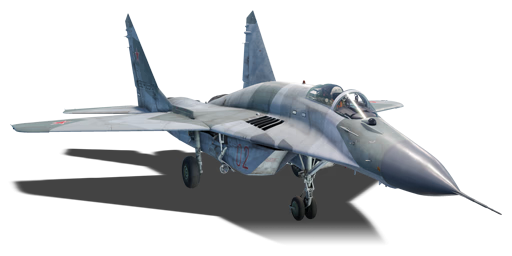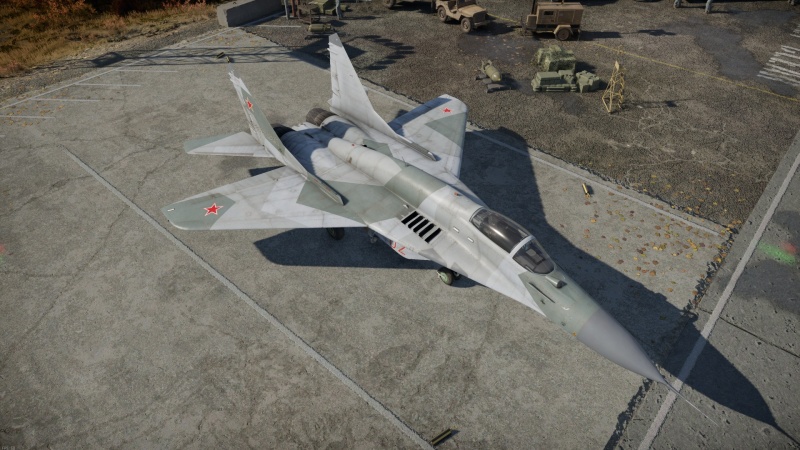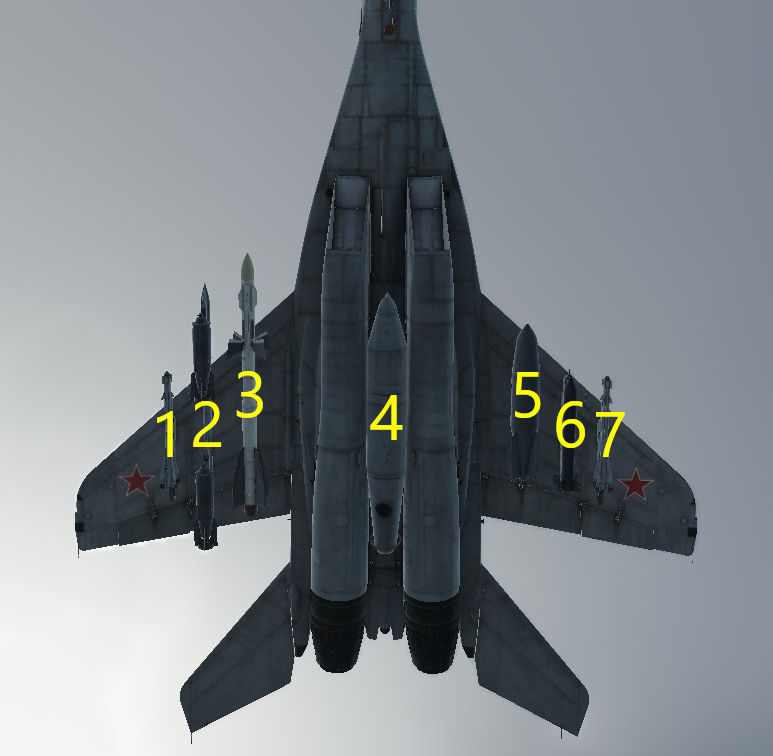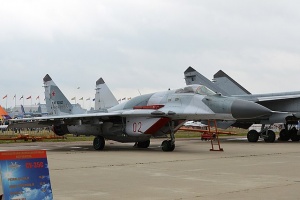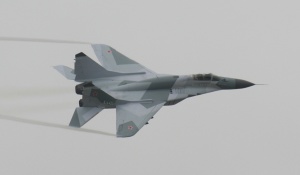MiG-29SMT
| This page is about the Soviet jet fighter MiG-29SMT. For other versions, see MiG-29 (Family). |
Contents
Description
By the turn of the millennium, the Russian VVS had fallen behind its adversaries again in terms of air power, due to the financial issues of post-Soviet Russia. With lack of funding resulting in the failure of the Mikoyan MFI and the MiG 1.44 program to produce a 5th generation frontline fighter to replace the MiG-29, a new aircraft was required to act as a counter to the latest F-16 variants and new Eurocanard fighters such as the Typhoon, Rafale, and Gripen. RSK MiG decided to restart development of their MiG-29SMT (9.17) from the mid-90s, and presented the idea of a MiG-29 modernized for the 21st century to the Russian government. With the cost savings of updating a older airframe being the main advantage, the development of the MiG-29SMT was greenlit, and the MiG-29SMT was heavily updated and upgraded into the 9.18 and 9.19 variants. To recoup some of the development costs, both variants were almost exclusively intended for export, with a special and slightly downgraded variant of the 9.19 created exclusively for the Russian VVS to save costs. The development of the 9.19 was finalized in 2006 with pre-production aircraft performing regular test flights and air-show demonstrations to lure foreign buyers. In the following years, the MiG-29SMT (9.19) would enter mass production where it would find homes with the Russian VVS, the Algerian Air Force, and the Syrian Arab Air Force.
The MiG-29SMT (9-19), introduced in Update "Sons of Attila", brings a new taste to a formidable beast that most top-rank pilots in War Thunder are familiar with. While the flight performance feels significantly worse than its predecessor, the previous MiG-29 (9.13), the new MiG-29SMT brings to the table a completely game-changing set of weaponry, including some of the best air-to-air missiles in the game such as the R-73 and R-27E family. This, combined with the upgraded avionics, radar, and upgraded assortment of guided ground ordnance for precision CAS, makes the MiG-29SMT a very dangerous and formidable aircraft in the top ranks of War Thunder.
General info
Flight performance
Describe how the aircraft behaves in the air. Speed, manoeuvrability, acceleration and allowable loads - these are the most important characteristics of the vehicle.
| Characteristics | Max speed (km/h at 12,000 m) |
Max altitude (metres) |
Turn time (seconds) |
Rate of climb (metres/second) |
Take-off run (metres) | |||
|---|---|---|---|---|---|---|---|---|
| AB | RB | AB | RB | AB | RB | |||
| Stock | 2,261 | 2,216 | 16000 | 23.1 | 23.5 | 257.5 | 244.8 | 750 |
| Upgraded | 2,442 | 2,347 | 21.9 | 22.5 | 346.1 | 300.0 | ||
Details
| Features | |||||
|---|---|---|---|---|---|
| Combat flaps | Take-off flaps | Landing flaps | Air brakes | Arrestor gear | Drogue chute |
| X | ✓ | ✓ | ✓ | X | ✓ |
| Limits | ||||||
|---|---|---|---|---|---|---|
| Wings (km/h) | Gear (km/h) | Flaps (km/h) | Max Static G | |||
| Combat | Take-off | Landing | + | - | ||
| 1,575 | 700 | - | 532 | 463 | ~10 | ~4 |
| Optimal velocities (km/h) | |||
|---|---|---|---|
| Ailerons | Rudder | Elevators | Radiator |
| < 680 | < 750 | < 700 | - |
Engine performance
| Engine | Aircraft mass | ||||||
|---|---|---|---|---|---|---|---|
| Engine name | Number | Basic mass | Wing loading (full fuel) | ||||
| Klimov RD-33 Series 3 | 2 | 11,670 kg | 435 kg/m2 | ||||
| Engine characteristics | Mass with fuel (no weapons load) | Max Gross Weight | |||||
| Weight (each) | Type | 12m fuel | 20m fuel | 30m fuel | 40m fuel | ||
| 1,050 kg | Afterburning low-bypass turbofan | 13,081 kg | 14,018 kg | 15,192 kg | 16,373 kg | 20,979 kg | |
| Maximum engine thrust @ 0 m (RB/SB) | Thrust to weight ratio @ 0 m (WEP) | ||||||
| Condition | 100% | WEP | 12m fuel | 20m fuel | 30m fuel | 40m fuel | MGW |
| Stationary | 3,920 kgf | 6,816 kgf | 1.04 | 0.97 | 0.90 | 0.83 | 0.65 |
| Optimal | 5,430 kgf (1,575 km/h) |
12,445 kgf (1,575 km/h) |
1.90 | 1.78 | 1.64 | 1.52 | 1.19 |
Survivability and armour
Examine the survivability of the aircraft. Note how vulnerable the structure is and how secure the pilot is, whether the fuel tanks are armoured, etc. Describe the armour, if there is any, and also mention the vulnerability of other critical aircraft systems.
Modifications and economy
Armaments
| Ballistic Computer | ||||
|---|---|---|---|---|
| CCIP (Guns) | CCIP (Rockets) | CCIP (Bombs) | CCRP (Bombs) | Lead indicator |
| |
|
|
|
|
Offensive armament
The MiG-29SMT is armed with:
- A choice between two presets:
- 1 x 30 mm GSh-30-1 cannon, cheek-mounted (150 rpg) + 60 x countermeasures
- 1 x 30 mm GSh-30-1 cannon + 60 x countermeasures + 56 x large calibre countermeasures
Compared to the basic MiG-29, the SMT is capable of mounting supplementary large calibre countermeasures for better self-protection.
Suspended armament
The MiG-29SMT can be outfitted with the following ordnance:
| 1 | 2 | 3 | 4 | 5 | 6 | 7 | ||
|---|---|---|---|---|---|---|---|---|
| 100 kg OFAB-100 bombs | 4 | 4 | 4 | 4 | ||||
| 250 kg FAB-250M-54 bombs | 1, 2 | 1, 2 | 1, 2 | 1, 2 | ||||
| 250 kg FAB-250M-62 bombs | 1, 2 | 1, 2 | 1, 2 | 1, 2 | ||||
| 250 kg OFAB-250Sh bombs | 1, 2 | 1, 2 | 1, 2 | 1, 2 | ||||
| 500 kg FAB-500M-54 bombs | 1 | 1, 2 | 1, 2 | 1 | ||||
| 500 kg FAB-500M-62 bombs | 1 | 1, 2 | 1, 2 | 1 | ||||
| 500 kg FAB-500Sh bombs | 1 | 1, 2 | 1, 2 | 1 | ||||
| 500 kg KAB-500Kr-E bombs | 1 | 1 | 1 | 1 | ||||
| ZB-500 incendiary bombs | 1 | 1 | 1 | 1 | ||||
| S-8KO rockets | 20 | 20 | 20 | 20 | ||||
| S-13OF rockets | 5 | 5 | 5 | 5 | ||||
| Kh-29TD missiles | 1 | 1 | ||||||
| R-27R missiles | 1 | 1 | ||||||
| R-27T missiles | 1 | 1 | ||||||
| R-27ER missiles | 1 | 1 | ||||||
| R-27ET missiles | 1 | 1 | ||||||
| R-73 missiles | 1 | 1 | 1 | 1 | 1 | 1 | ||
| 2,000 l drop tanks | 1 | |||||||
| Maximum permissible weight imbalance: 1,500 kg | ||||||||
| Default weapon presets | |
|---|---|
| |
The MiG-29SMT's upgraded arsenal is one of its main selling points. As such, it is worthwhile to discuss their properties, as knowing them will be key to achieving high-kill games.
R-73: A candidate for the best Infrared Homing short-range missile in War Thunder:
The R-73 will be your primary missile for short-range engagements, and it is a capable missile with a number of features that will make it stand out among every other missile at the Battle Rating.
The first of these features is the seeker of the R-73, for it is the most capable all-around short-range seeker in the game. With an above average sensitivity to planes compared to flares, greater than a 1:1 ratio, the R-73 is more likely to follow a target through their countermeasures than almost any other missile in the game, and the benefits do not end here. The seeker of the R-73 also incorporates IRCCM, which it isn't the first top tier jet missile to do (this honor goes to the R-27T), it is almost certainly the most capable IRCCM model in the game. To be specific, the missile's seeker, once launched, will shrink from around 4.5 degrees of view, to around 0.75 degrees of view. This IRCCM, called 'gatewidth' is one of the two major types of IRCCM for air-to-air missiles found in the game, the other one being 'tracking suspension' IRCCM, found on missiles like the AIM-9M. Comparing the two, gatewidth is superior against manuevering targets that are flaring at close range, as instead of suspending guidance and going inertial in the target's last known direction when it sees a flare, it attempts to not see flares in the first place.
The same gatewidth and sensitivity values are also found on missiles like the Matra R550 Magic 2, and a similar gatewidth and seeker (with a larger FOV and better sensitivity) are found on the R-27T and R-27ET, too. Thus, what separates the R-73 from it's peers is the best-in-class manueverability, combining a pull of up to 40G with thrust vectoring, making this missile pull in and score kills in situations and distances that no other missile in the game can, be it infrared or radar homing. This is all on top of a much improved rocket booster compared to it's predecessor, the R-60M, increasing the reliable range at which it can score a kill at up to 3km.
R-27R/R-27T: Slow, short-range, extremely fun and extremely deadly:
The R-27 missiles return to the MiG-29SMT, coming in 4 variants. This will look into the first two variants, the R-27R and the R-27T.
By now, these missiles should both be familiar tools to anyone who has used the predecessor of the SMT, the MiG-29 (9-13), or the Yak-141.
They are slow to accelerate to reasonable speeds, can pull up to 35G in almost all scenarios, and have a firing range similar to an AIM-7M Sparrow, or the AIM-9L, respectively. However, they are superior to both in other ways.
The R-27R has a superior seeker compared to the AIM-7M, with overall superior tracking characteristics. To add to this, the R-27R has two special features which aid in acquiring and tracking targets, the first being In-Ordnance Guidance (IOG). This feature helps the missile stay on course in the event a lock is weak for short periods of time. The second feature is Datalink (DL). This feature gives the missile the ability to resume tracking (successfully or not) a target after it already lost track of one, at any time within the Missile Guidance Time allotted, and will not explode on it's own during this time. Instead, when a lock is lost, the missile will fly to the last known radar returns of the target and fly randomly from there. Due to the lack of range (and thus, lacking BVR capabilities) on the R-27R, datalink is most used for regaining a lock and scoring a kill before the missile passes the target.
The R-27T, likewise has a superior seeker compared to most IR missiles in the game, with a FOV of 2 degrees before launch, decreased by gatewidth to 1.33 degrees after launch. It is one of the most, if not the most, sensitive IR seekers, with a sensitivity ratio of planes to flares that significantly exceeds 1:1. Unlike the R-27R, the T variant lacks any of the special features, and the missile is still entirely independent of the airframe that launched it.
R-27ER/R-27ET: Familiar, and better than ever:
Likewise, anyone who has played the MiG-29 or Yak-141 will have seen the R-27ER. This missile's seeker is identical to the R-27R, but the new rocket booster and sustainer means acceleration, maximum speed, and range are greatly increased to upwards of 10+ km when fired on the deck, and up to 30-40 km at BVR altitude. As such, manueverability may slightly suffer initially due to the great acceleration, but will continuously pull in the long run due to the excess of energy remaining.
The R-27ET, however, is likely less familiar, due to it being introduced with the MiG-29SMT and only retroactively added to the Yak-141. It is an R-27T with an identical seeker and an identical lack of special features like IOG or DL, but has the same improved rocket booster and sustainer of the R-27ER, meaning it has near-identical range to it, upwards of 10-11 km. This is excellent, as it now can reach the targets that the seeker locks on to from distances of 13-15 km without significant issue. This also means the missile is capable of reaching a target that never saw the airframe launching this missile, without an RWR to warn of it's approach.
The ground attack arsenal sees several improvements. In terms of unguided weapons, the bomb loadout remains the same but the older S-24 HE rocket has been replaced with the podded S-13OF, which has somewhat less HE power but five times the capacity per pylon. The inner pylons can now mount TV-guided munitions in the form of the Kh-29TD (functionally identical to the Kh-29T seen on other Soviet jets) and the KAB-500Kr, which are nice to have in mixed battles for standoff attacks against SPAA. However, the capacity of only two such munitions is much lower than comparable American jets like the F-16C, which can not only carry three times as many air-to-ground missiles but also has a targeting pod and laser-guided bombs. Thus, while the MiG-29SMT is a useful multirole fighter, pilots shouldn't expect to be able to clear out an entire enemy team in one run.
Usage in battles
Air Combat
While the MiG-29SMT has reduced manoeuvrability from the added fuel tank compared to the MiG-29 9-13 (combined with the lack of any engine upgrade over the aforementioned MiG-29), it's still extremely strong in air combat. You merely have to be mindful of the increased weight and worse performance when dogfighting, as you are unlikely to win in a pure dogfight over other airframes with more capable flight models, such as the F-16A, F-16B, F-16C, JAS39A/C Gripen, F-15A/J, and the Mirage 4000.
When it comes to BVR, the MiG-29SMT dominates with the R-27ER missile, and its powerful radar, the Zhuk-M (a radar set very familiar to those who have played the Yak-141), with good tracking properties, good notching resistance, and good range. This, along with the new SPO-150 RWR that increases situational awareness by giving information about the exact vehicle that's pinging the MiG-29SMT, makes it perfect for BVR combat. The R-27ER also makes it adept at Within-Visual-Range engagements at the deck, against someone flying above you, as this missile can easily hit targets at the 10km range of the HMD you are provided, with limited hope of evasion when the missile accelerates up to it's top speed, should they never dive down.
The MiG-29SMT is also strong in close-range engagements. It carries the R-73, which is an extremely effective heat-seeking missile with 40G overload (combined with thrust vectoring) and sufficient 3 km overall range, combined with one of the best flare resistance models in the game. You'll want to use this missile at distances less than 1.5 - 2 km and parallel to the target for the best results, as the missile, if launched correctly, can and will pull in with little difficulty, remaining near-unflareable unless flares are visible before launch.
CAS (Close Air Support)/Ground Attack
The MiG-29SMT has amazing ground ordnance that allows it to take down ground targets reliably. The TV guided KAB-500Kr-E bombs are incredibly useful, enough to take down several tanks with ease when multiple bombs are dropped. And if you mix the TV guided bombs with the new and improved Kh-29TD air-to-ground missiles, it becomes the perfect aircraft to attack ground targets while remaining viable as a fighter.
You can also select traditional dumb bombs and rockets that, if used with precision, can be lethal to anything that crosses their path.
Pros and cons
Pros:
- Incredibly versatile weapon systems; some of the best air-to-air missiles in-game
- Very effective radar, IRST, and HMD targeting systems
- Unlike its predecessor, it has an improved digital RWR that increases awareness.
- Great upgrade in CAS capabilities over its predecessors
- "Rita" voice warning system
Cons:
- Increased weight over previous variants; heavily downgraded manoeuvrability and acceleration
- Bleeds energy dangerously fast during manoeuvres
- Less countermeasures than majority of its adversaries
History
After the dissolution of the USSR, the Russian Federation sought to find a replacement for its aging older Su-27 and MiG-29 fighters, to match the 4+ and 5th generation capability of its NATO adversaries. The original program for a frontline fighter replacement for the MiG-29, the Mikoyan 1.44, failed due to lack of funding in post-Soviet Russia. Eventually, the Russian Federation would settle for heavily upgrading their existing MiG-29s into 4+ generation standards as a stop-gap solution not only for them, but also for export customers. The resulting project built upon Mikoyan's older Project 9.17A, the original MiG-29SMT from 1996, upgrading it with 21st century avionics and equipment.
The "new" MiG-29SMT was split into two models, airframe numbers 9.18 and 9.19, and was developed throughout the early 2000s not only as Russia's new frontline fighter to replace the older MiG-29s, but also as a proper 4+ generation upgrade for export customers still using the older MiG-29A and MiG-29S, and as such was redesigned from the ground up. The new MiG-29SMT would incorporate a plethora of upgrades to differentiate it from all previous MiG-29s, and easily placing it on the same level of technological advancement as some other 4+ generation fighters. The MiG-29SMT, first and foremost, revamped the airframe and how it is controlled. The SMT received reinforced wings and fuel tanks to increase its range, and to account for the weight increase and changes in control, the aircraft features a hybrid control system of both mechanically linked hydraulics and fly-by-wire. The powerplant also included the option for uprated, higher thrust engines for export customers, as the Russian VVS opted out of this engine upgrade to keep unit costs down. One of the primary upgrades for the SMT was extending the poor range of previous MiG-29 variants. This was achieved by not only making the saddle fuel tank noticeably larger (giving the SMT its "hunchback" appearance), but by also adding a in-flight refueling probe on the portside of the nose, allowing for mid-air refueling. The 9.18 variant lacked the larger saddle tank to keep costs down and was marketed primarily for export to smaller countries where longer range was not a important factor. Yemen would be the only customer to purchase the 9.18.
The MiG-29SMT also featured a full overhaul to its avionics suite, with the most important changes being the new Zhuk-M (N-010ME) radar, a modernized and heavily upgraded variant of the older N010 Zhuk originally intended for the Yak-141, specific variants of the Su-27, and the MiG-29M modernization program. The new radar and fire control system were also linked to a new, state-of-the-art "Glass-cockpit" design, where instrumentation was either digitalized, or kept at a minimum for the sake of incorporating Color Multi-function Displays in the cockpit, to streamline the pilot's workload. The new radar and fire control system also allowed the new MiG-29SMT to carry a upgraded arsenal of weaponry, namely the R-74 and R-77 missiles, while also expanding upon the aircraft's CAS capabilities with new ground ordnance such as the Kh-29TD, Kh-31, and KAB-500Kr. The MiG-29SMT's fire control system also included software giving it compatibility with laser ordnance if a laser targeting pod was equipped, and compatibility with some NATO ordnance and targeting systems, intended for export customers' use with mixed hardware.
The MiG-29SMT (9.19) would first take to the skies in 2006, with deliveries to the Russian VVS starting in the following years. The 9.19 would also be exported to multiple countries throughout the 2010s, primarily Algeria and Syria, where it would see decent success in active combat with the latter country in the ongoing civil war. The same could not be said about Algeria, who had opted for the aforementioned option of having upgraded engines, but ended up returning some of the aircraft due to the engines being defective, and acquiring Su-30 aircraft instead to replace the defective MiG-29SMTs.
Media
- Skins
- Videos
See also
- Related development
External links
| Mikoyan-Gurevich Design Bureau (Микоя́н и Гуре́вич Опытное конструкторское бюро) | |
|---|---|
| Fighters | MiG-3-15 · MiG-3-15 (BK) · MiG-3-34 |
| I-225 | |
| Jet fighters | MiG-9 · MiG-9 (l) |
| MiG-15 · MiG-15bis · MiG-15bis ISH | |
| MiG-17 | |
| MiG-19PT | |
| MiG-21F-13 · MiG-21PFM · MiG-21S (R-13-300) · MiG-21SMT · MiG-21bis | |
| MiG-23M · MiG-23ML · MiG-23MLD | |
| MiG-27M · MiG-27K | |
| MiG-29 · MiG-29SMT | |
| Export/Licensed | ␗MiG-9 · ␗MiG-9 (l) |
| ◊MiG-15bis · ◔MiG-15bis · J-2* | |
| MiG-17AS · ◔MiG-17PF · J-4* · Shenyang F-5* | |
| ◊MiG-19S · J-6A* | |
| ◄MiG-21 SPS-K · ◊MiG-21MF · ◔MiG-21MF · ▄MiG-21bis · ◔MiG-21bis-SAU · ◊MiG-21bis-SAU · ◊MiG-21 "Lazur-M" · J-7II** | |
| ◊MiG-23BN · ◊MiG-23MF · ◔MiG-23MF · ◊MiG-23MLA | |
| ◔MiG-29 · ◊MiG-29 · ◄MiG-29G | |
| *Licensed and domesticated with Chinese designations. | |
| **Unlicensed, reverse-engineered and domesticated with Chinese designations. | |
| See Also | Shenyang · Chengdu |
| USSR jet aircraft | |
|---|---|
| Bereznyak-Isayev | BI |
| Yakovlev | Yak-15 · Yak-15P · Yak-17 · Yak-23 · Yak-28B · Yak-30D · Yak-38 · Yak-38M · Yak-141 |
| Mikoyan-Gurevich | MiG-9 · MiG-9 (l) · MiG-15 · MiG-15bis · MiG-15bis ISH · MiG-17 · MiG-17AS · MiG-19PT |
| MiG-21F-13 · MiG-21PFM · MiG-21S (R-13-300) · MiG-21SMT · MiG-21bis | |
| MiG-23M · MiG-23ML · MiG-23MLD · MiG-27M · MiG-27K | |
| MiG-29 · MiG-29SMT | |
| Lavochkin | La-174 · La-15 · La-200 |
| Sukhoi | Su-9 · Su-11 |
| Su-7B · Su-7BKL · Su-7BMK · Su-17M2 · Su-17M4 · Su-22M3 | |
| Su-25 · Su-25BM · Su-25K · Su-25T · Su-25SM3 · Su-39 | |
| Su-27 | |
| Ilyushin | IL-28 · IL-28Sh |
| Tupolev | Tu-14T |


